‘Street Dreams’ Come True at a Bronx School Library
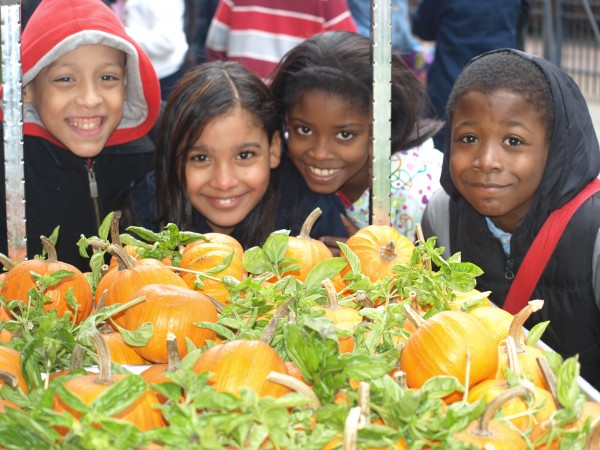
Students with produce from the P. S. 54 garden. Other library initiatives have included programs on healthy eating, fitness, community leadership, and more.
Ask any person in an urban setting, and they will tell you that the oldest street dream is to rise from the ashes of poverty, and build yourself up with powerful resources in order to be respected. This same adage holds true for inner-city school libraries like the one at P.S. 54, a New York City public elementary school just off of Fordham Road in the Bronx.
P.S. 54 is nestled next to Snake Hill, a twisted enclave with a longstanding history of being a drug hotspot. Drug dealers fearlessly stake out their territory, as cops are nowhere to be seen. On any given weekday morning, you can walk down the back road of the school, Decatur Avenue, and see several grown men perched against apartment buildings, as whiffs of marijuana permeate the street. Later in the day, these same streets bear witness to children walking home alone or happily running through the sidewalks playing or riding scooters.A street dream come true
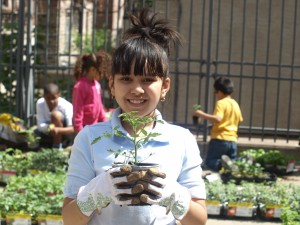
More fruits from the P. S. 54 garden.
For two years, the P.S. 54 school library was defunct after the former principal’s longtime friend retired as the school librarian. Upon reopening under my leadership in 2012, the library had only two antiquated PCs for the school’s population of 475 children. Several students were inept at navigating online sites, since they did not have computers or Web access at home. Because so many of the seemingly regular apartment buildings in the neighborhood are used to house homeless families, the school’s student population has always been very transient and has contributed to P.S. 54 being a failing school.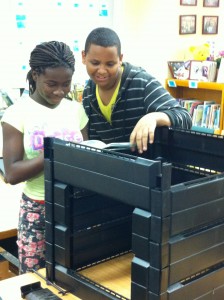
Students consult instructions while assembling a new composting bin.
Fast forward to 2014, and the school library is living proof that the oldest street dream can come true. It has become a real library media center. By quickly forging alliances and building partnerships with community-based organizations that have similar goals and dispositions, I’ve been able to build resources and create learning opportunities that few inner city children have ever heard of, let alone get the chance to experience. Now, through a library gardening initiative, it is not unusual to see children crouching down diligently working under the hot sun as they plant eggplants, peppers, tomatoes, parsley, and sage. Scholars weed without complaining as they pile up debris to be later thrown into the compost box, which will make soil for the garden. Two children argue over whose turn it is to water, as they both relish in spraying plants without fear of reprisal. Young “cafeteria rangers” comb through the lunchroom trash, smiling as they recount who obtained the most apple cores or orange peels. Then they happily throw the food trash into the compost bin and take turns aerating it. On any given day, you can also go into the library and see children typically infamous for their behavior problems breathing calmly as I lead them in yoga. I have always found that after a stressful day at work, yoga helps me release frustrations. It helps them as well. Children, on hands and feet, push their little bodies up to form human triangles known as “downward dog,” trying to perfect the pose. Library classes also do hands-on recycling crafts after read-aloud sessions revealing that the average person generates seven pounds of garbage a day.Transformation in action
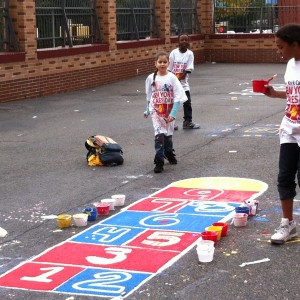
A school improvement day with the organization New York Cares.
How did I transform my library? While many suburban schools and libraries have a wealth of resources, inner-city schools and libraries like mine are in a drastically different position. Many New York City schools have faced budget cuts resulting in principals eliminating libraries altogether, or in principals claiming New York State Textbook Law (NYSTL) funds for general school use instead of collection development. It is a rare NYC Department of Education (DOE) principal who will allocate funds for library programming. However, through careful planning, a great deal of collaboration, a whirlwind of grant writing, and some imagination, I’ve been able to foster critical thinking and promote lifelong learning by obtaining additional resources and collaborating with community-based organizations. While the names of the organizations may change from city to city, you can certainly find similar ones near you with like-minded missions. Here are several examples of the organizations I worked with and the story of how our partnerships helped my school library find success.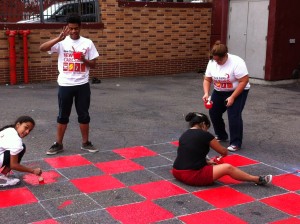
More activities with New York Cares.
- New York Cares is a nonprofit that organizes numerous good Samaritans who go into low-income neighborhoods to volunteer. I collaborated with them to beautify the school. Several alumni groups and a financial firm came in on a Saturday and organized classroom libraries, created outdoor pallet benches for the school’s garden, and painted beautiful murals to be hung up in the auditorium.Seeing complete strangers so helpful and eager to make a difference in their community, many parents also came to volunteer with their children. Working side-by-side and focusing on a common goal of improving the school environment, our students had fun while learning first-hand how to contribute as upstanding community members.
-
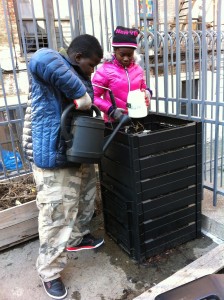
Composting.
Citizens Committee for New York City (Citizens NYC)’s mission is to improve the quality of life in low-income neighborhoods. This nonprofit organization provides workshops to help resident-led groups navigate the city government and mobilize neighbors and raise grant funds for community projects. It also provides equipment to share such as tents, video projectors, projection screens, amplifiers and cameras that bring communities together for fundraisers, neighborhood movie nights, or any type of improvement activity. Citizens NYChelped my library by funding our scholar-created garden. Parents and community members also got on board and helped plan, plant, and maintain this environmental initiative. Citizens NYC and HSBC Bank also sponsored a $5,000 contest on water conservation, which our school library won. Fourth and fifth-grade students brainstormed about different ways to conserve water, and their aim was to determine how to create water out of thin air. By tying plastic baggies to tree branches, they trapped the water the plants had stored. They also used dehumidifiers and recycled that water for the school garden. My students’ project-based learning is led and reinforced with literacy. As the projects culminated, they used technology platforms to showcase their learning and present it to others. -
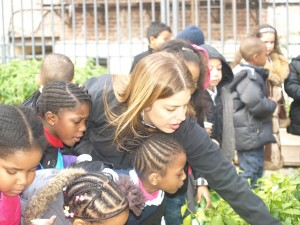
A garden harvesting event.
CookShop NYC is a nonprofit organization and a division of the Food Bank of New York City. This anti-poverty, non-traditional group uses innovative strategies to end hunger. CookShop provides lessons, handouts, materials, and fresh produce for students to learn how to create healthy food and snacks. Once the school enrolls several classes the CookShop program classroom teachers are provided training to lead the program for a 45 minute period, once a month during school hours. CookShop also encourages involvement through parent workshops, which I led at P. S. 54, so that students’ learning about healthy foods and eating habits would have a greater chance of being reinforced at home. Food Bank of NYC provided adult participants with a “homework baggie” of fresh produce so that they could try the workshop recipes at home.
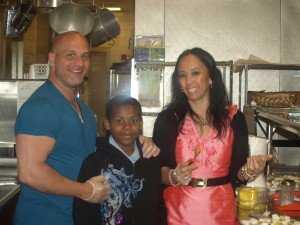
Gym teacher Tony Diglio, P. S. 54 student Lashon, and librarian Tracey Wong preparing a "healthy breakfast grab" as part of the Fuel Up to Play 60 initiative.
- Fuel Up to Play 60 is a program sponsored by the National Dairy Association and the NFL in collaboration with the U.S. Department of Agriculture. Through workshops lead by NFL players and fitness/health professionals, students are empowered to become active for 60 minutes each day and to make healthy food choices. I used this program to collaborate across the curriculum with the gym and classroom teachers on subjects including farm-to-table eating, geographic awareness of what crops grow where, environmental studies, ecology, and plant parts. Not only did children win great prizes like shirts, backpacks, and NFL game tickets and get inspired by professional athletes, they also learned about living healthy lifestyles and making a difference in other people’s lives.
-
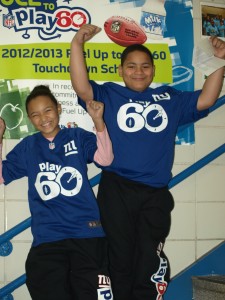
P. S. 54 students attended an NFL game as part of Fuel Up to Play 60.
Lastly, the school library media center drew upon local resources in order to obtain resources for its shareholders. The Fund for Public Schools underwrote six desktops and six iPads, and promoted family reading nights with giveaway books and refreshments sponsored by Target. I also appealed to the office of the Bronx Borough President, Ruben Diaz Jr., for three Smart boards and 58 laptops in order to build the library’s media and technology and for the school. All of these were fully funded.In essence, the street dream is a dream of rebirth and regeneration while obtaining power and respect. Who hasn’t dreamed about starting anew, being fierce and wildly successful?
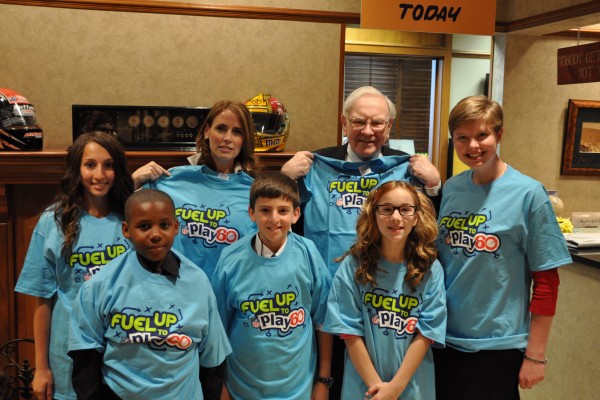
Students across the country who won a Fuel Up to Play 60 contest were invited to attend boardroom meetings with investor-philanthropist Warren Buffett (top row, second from right), who also offered advice to the students. P. S. 54's Lashon is at lower left.
Author Tracey Wong is a 13th year NYC DOE veteran. This is her third year as a school librarian media specialist at P.S. 54 in the Bronx, NY.RELATED
The job outlook in 2030: Librarians will be in demand
The job outlook in 2030: Librarians will be in demand
ALREADY A SUBSCRIBER? LOG IN
We are currently offering this content for free. Sign up now to activate your personal profile, where you can save articles for future viewing






Add Comment :-
Be the first reader to comment.
Comment Policy:
Comment should not be empty !!!